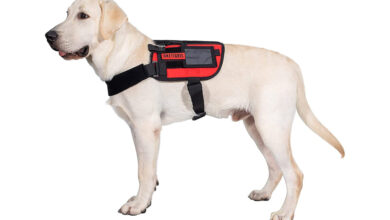Keep Your Pup Cozy & Comfy: A Step-by-Step Guide to Winterizing Your Dog Door!

1. Introduction
Winterizing a dog door is an important step for any pet owner that wants to keep their furry friend safe and comfortable during the cold winter months. Winterizing a dog door involves making sure that the door is properly insulated, sealed, and weather-stripped in order to keep out drafts and cold air. This process not only helps keep your pet warm but also helps reduce energy costs by preventing heated air from escaping outside.
2. Benefits of Winterizing Your Dog Door
Winterizing your dog door has many benefits for both you and your pet. Not only does it help keep your pet warm and comfortable during the winter months, but it can also help reduce energy costs as well. By preventing heated air from escaping outside, you can save money on heating bills as well as help protect the environment by using less energy. Additionally, winterizing your dog door can help prevent drafts from entering your home which can cause discomfort and health issues such as allergies or asthma.
3. Things You Need to Winterize a Dog Door
Before you begin winterizing your dog door, there are a few supplies that you will need to gather first:
• Weather stripping – This material is used to seal the edges of the door in order to prevent drafts from entering or exiting through gaps or cracks around the frame of the door
• Insulation – This material is used to fill any gaps or cracks around the frame of the door in order to provide an extra layer of protection against cold air
• Caulk – This material is used to seal any seams or cracks between two pieces of material such as wood or metal
• Screws – These are used to secure weather stripping and insulation materials in place
4. Steps to Winterize a Dog Door
Once you have gathered all of your supplies, you can begin winterizing your dog door with these simple steps:
Step 1: Measure and Cut Weather Stripping – Begin by measuring the perimeter of your dog’s door frame with a measuring tape and then cut pieces of weather stripping according to those measurements using scissors or a utility knife.
Step 2: Install Weather Stripping – Apply adhesive backing (if necessary) onto each piece of weather stripping before pressing them firmly into place around the perimeter of the frame using a putty knife or other flat surface tool. Make sure that each piece is securely fastened into place before moving onto step three.
Step 3: Add Insulation – Cut pieces of insulation according to measurements taken in step one and then press them firmly into place around all sides of the frame using a putty knife or other flat surface tool until they fit snugly against each side without leaving any gaps or cracks between them.
Step 4: Seal Edges – Use caulk along all seams where two pieces meet (such as wood or metal) in order for them seal together completely without leaving any gaps for cold air to enter through. Allow caulk time dry completely before proceeding with step five.
Step 5: Secure with Screws – Finally use screws along each side where two pieces meet (such as wood or metal) in order for them seal together securely without leaving any gaps for cold air to enter through when closed shut tightly against one another. Allow screws time dry completely before testing out if it works properly when opened/closed shut tightly against one another without letting any cold air enter through it when closed shut tightly against one another again after testing out if it works properly when opened/closed shut tightly against one another again after testing out if it works properly when opened/closed shut tightly against one another again after testing out if it works properly when opened/closed shut tightly against one another again after testing out if it works properly when opened/closed shut tightly against one another again after testing out if it works properly when opened/closed shut tightly against one another again after testing out if it works properly when opened/closed shut tightl yagainst one another once more..
5 Tips for Installing Weather Stripping Around a Dog Door
Installing weather stripping around a dog door requires precision and patience so here are some tips that can help make this process easier:
• Measure twice; cut once – Before cutting any pieces of weather stripping make sure that you have measured twice so that they fit perfectly into place without having too much excess material left over which could cause drafts from entering through small openings between two pieces meeting up at their edges;
• Use adhesive backed strips – Adhesive backed strips are great because they stay in place better than regular strips which may come loose over time due to wear and tear;
• Use caulk along all seams – When installing insulation make sure that you use caulk along all seams where two pieces meet (such as wood or metal) in order for them seal together completely without leaving any gaps for cold air to enter through;
• Secure with screws – Finally use screws along each side where two pieces meet (such as wood or metal) in order for them seal together securely without leaving any gaps for cold air to enter through;
• Test often – After completing installation check often throughout winter season whether there are still no drafts coming through by opening/closing dog doors several times while checking whether there are still no drafts coming through by opening/closing dog doors several times while checking whether there are still no drafts coming through by opening/closing dog doors several times while checking whether there are still no drafts coming through by opening/closing dog doors several times while checking whether there are still no drafts coming through by opening/closing dog doors several times while checking whether there are still no drafts coming through by opening/closing dog doors several times..
6 How To Insulate A Dog Door
Insulating a dog door is important because not only does this provide an extra layer protection from cold temperatures, but also helps reduce noise levels inside home since sound waves travel faster colder temperatures than warmer ones do.Here’s how insulate your doggie’s entryway :
Step 1: Measure Your Door Frame- Begin by measuring perimeter doggie’s entryway with measuring tape then cut appropriate sized pieces insulation according those measurements using scissors utility knife.
Step 2: Install Insulation- Apply adhesive backing (if necessary) onto each piece insulation before pressing firmly into place around perimeter doggie’s entryway using putty knife other flat surface tool.Make sure each piece securely fastened into place before moving onto next step.
Step 3: Secure With Tape- Once all insulation has been installed,use strong duct tape secure insulation firmly into place.Make sure tape covers entire area ensure maximum protection from sound waves.
7 How To Seal The Edges Of A Dog Door
Sealing edges doggie’s entryway important part keeping warm temperatures inside home during colder months year.Here’s how seal edges doggie’s entryway :
Step 1: Measure & Cut Weather Stripping- Begin measuring perimeter doggie’s entryway with measuring tape then cut appropriate sized pieces weather stripping according those measurements using scissors utility knife.
Step 2: Install Weather Stripping- Apply adhesive backing (if necessary) onto each piece weather stripping before pressing firmly into place around perimeter doggie’s entryway using putty knife other flat surface tool.Make sure each piece securely fastened into place before moving onto next step.
Step 3: Caulk Seams- Use caulking gun apply caulk along all seams where two materials meet such wood metal ensure complete sealing between surfaces prevent drafty areas forming due small openings between materials meeting up at their edges.Allow caulk time dry completely before proceeding next step.
Step 4: Secure With Screws- Finally use screws secure weather stripping insulation materials firmly into place ensure maximum protection from drafty areas forming due small openings between surfaces meeting up at their edges..



